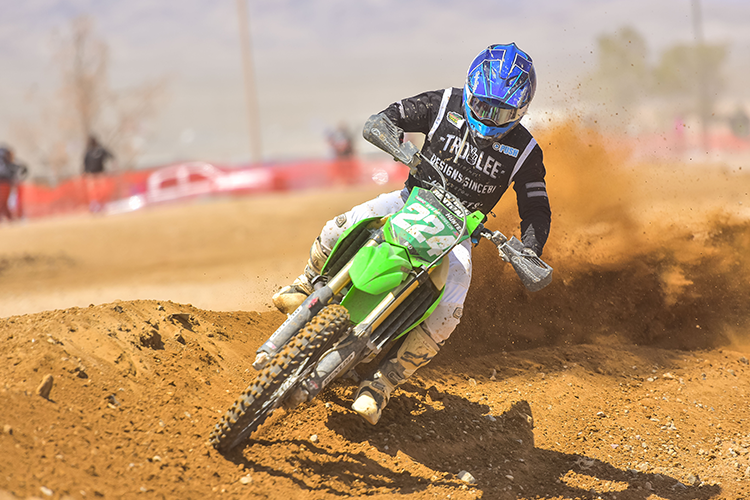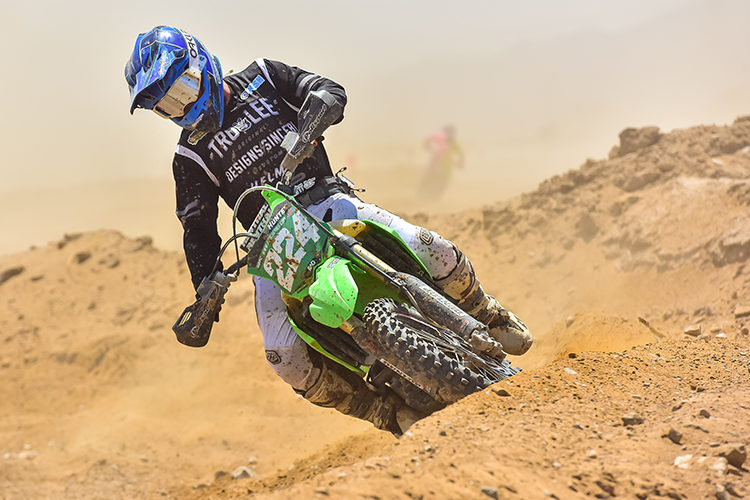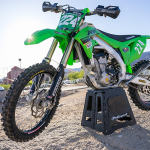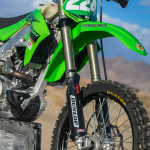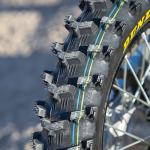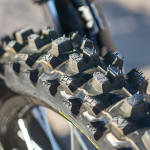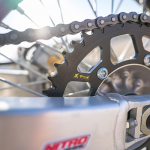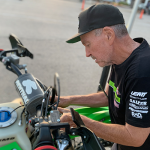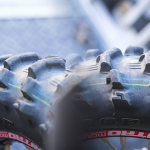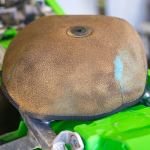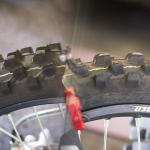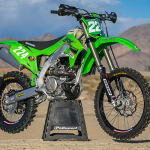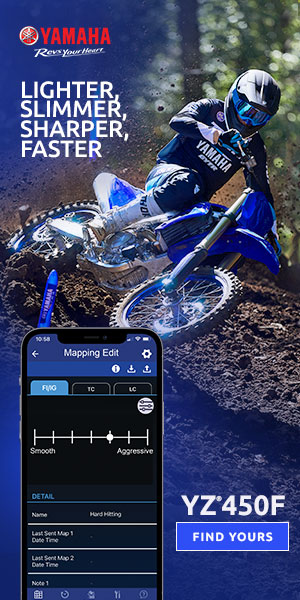KX250X Minimalist Race Build
Story by Trevor Hunter, Photos by Trevor Hunter, Mad Moose Media
After wrapping up our 2022 250F XC Shootout, I was more than impressed with the performance of the KX250X and felt the urge to line it up and see how it worked under race conditions. Being identical to the 2021 edition, I knew it didn’t need much to be a competitive platform after having success at the 6 Hours of Glen Helen last year. This year, we’d be taking the bike to Primm, NV for the fifth round of the AMA Big6 National Grand Prix Championship and race it under more familiar conditions against some stacked competition.

To start, very minimal time beforehand again left making modifications to the bike minimal, but part of the journey here is seeing how far we can push this bike in a near stock platform. Three of the five mods to our KX were made out of necessity, the other two were made out of curiosity. The three essential mods include an IMS 2.8 gal tank with quick fuel (loaned by the Precision Concepts Kawasaki Team), along with Nitromousse’s and Dunlop Tires.
The stock tank isn’t enough to complete a full one-hour long race on, we tried, and the Pro main event that lasts 90+ minutes meant a quick refueling would be necessary.
For flat prevention, we went with Nitromousse foam inserts and stuffed them in Dunlop tires. Our tire choice was sort of unusual for this weekend, but it turned out to be a very good pick. Up front, we went with a Dunlop MX33F since the course is 95% sand with only a few small sections of hard pack. Out back, we mounted a Dunlop MX12 scoop tire knowing it’d be beneficial in the sand and there was little enough hard pack that the good would likely outweigh the bad.
Kawasaki equips the 250X with a 51T rear sprocket instead of a 50T like the MX bike, and for faster conditions like we see out west and in Primm, it doesn’t work quite as well. We find ourselves having to make quick shifts and running out of gear in a hurry, so dropping to a 50T or even a 49T depending on the terrain really helps here.
Our final modification was an ECU remap by Precision Concepts Racing. They advanced the ignition timing by anywhere from 1-3% throughout the curve, and richened the fuel delivery by anywhere from 1-3% throughout the range and designed it to be used with the green mapping coupler. And with that, it’s time to go racing!
The terrain in Primm consists of a blue-grooved truck track, some harder packed desert dirt, and a lot of sand with a fairly high overall speed around the whole track. With 1300+ racers on track over the weekend, the 7.5 mile course roughens up quickly and will put any bike to the test in terms of handling.
Overall, I had the best weekend of racing I’ve had in a while on the KX. Our finishes were 4th 250AA on Saturday, though most use that as more of a practice than a race, and 8th Pro 2 on Sunday.
The bike is a blast to ride and race, requiring aggression to go fast, yet it’s easy to ride this bike aggressively and not tire you out. The ECU reflash by Precision Concepts brought a lot of life out of this motor, specifically down low. The top end has always been good but we would’ve liked a little more juice in the bottom-mid and that’s exactly what the remap gave us, while still pulling as good as any on top. We were able to hang with or even slightly pull most 250F’s and some 250 two-strokes if we weren’t out-geared.
The Dunlop MX33F/MX12 tire combo proved to be a good choice and we will have zero hesitations about running it again next year and at some of the other sandier tracks we visit. The scoop tire worked very good just about everywhere and performed better than we expected on the hard pack. Running it, we learned a few things to be aware of, but when you know what to expect and learn how to ride with it, we feel the advantages far outweigh the drawbacks. Under braking, the rear end doesn’t track straight all that well, but it still brakes better than some other non-Dunlop scoop tires we’ve run. Additionally, the rear tire still hooks up well on the hard pack, but when it cuts loose, it really cuts loose. It’s best to tone it down a notch on the hard pack and avoid spinning too much as we almost learned the hard way. You’ll go from full traction to zero in a split second, whereas a normal tire will give you more of a warning and slowly step out from under you. Still, we felt it was a net gain on the track, not to mention how well it hooked up on the start. We equate it to running a gummy tire in rocks vs a normal tire – it just hooks up and goes and gives you more traction and better pull than you thought was possible.
The stock suspension worked very well, and had we had some more time with the bike, we would have improved it slightly but not much. The forks needed a little more bottoming resistance, and simple things like stiffer fork springs or even just adding oil would have made these forks work better for the ultra rough conditions. The shock was definitely on the soft side and bottomed a little too much in the bigger sand whoops, but at no point did we feel it was dangerous or that it was really holding us back that much. Still, in stock trim with nothing but a couple of small clicker changes, this bike finished inside the Top 10 of the Pro 250 class at one of the roughest courses of the season, showing how capable it is even in stock trim.
Below are the stock suspension settings vs the settings we raced with.
Stock/Race:
Fork –
C- 10 | 9
R – 13 | 13
Shock–
LC – 8 |5
HC – 1.5 | 1.5
R – 15 | 17
Handling, the Kawi’s bump absorption and overall comfort is one of the best in class. The chassis soaks up hard hits and square edges with little deflection. Turning on the KX is improved when putting the IMS tank on. Previously, we felt the unweighted front end was tougher to turn, but putting a little extra weight up front with the gas tank helps the Kawi turn down in corners and get more front end traction out of it. We ran the sag at ~106 for a good mix of turning precision without sacrificing too much stability, though we felt the need for a stabilizer for the faster sections of the course. By running any more or less sag or fork height, we felt we’d be giving up too much stability or cornering performance so we opted for these settings. Primm is tough to set up for since there are so many tight turns mixed with some very high speed and choppy straightaways.
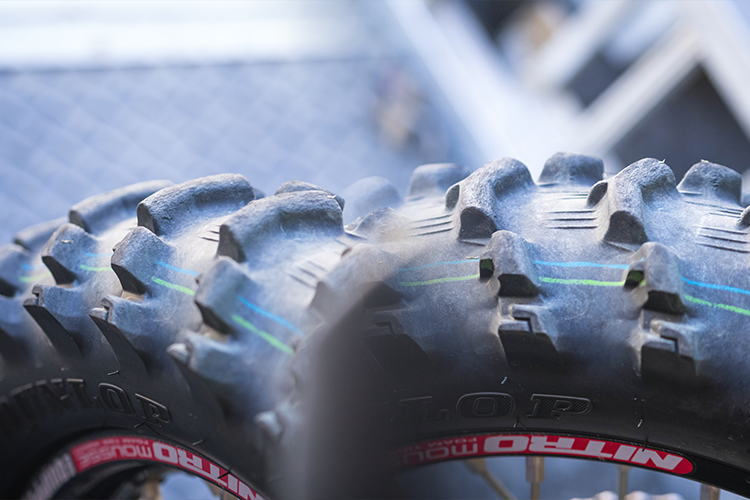
To wrap it up, the KX250X is a pure-bred racer off the showroom floor and with just a couple simple changes, we mixed it up with the fastest 250cc off-road racers on the west coast on a largely stock setup. These days, almost all bikes are very capable out of the crate and this shows how little you really need to go racing, even at a high level.






